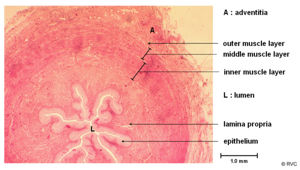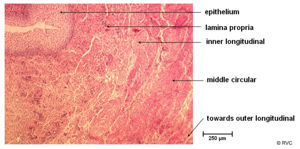Difference between revisions of "Equine Urinary System - Horse Anatomy"
| Line 44: | Line 44: | ||
==Ureters== | ==Ureters== | ||
| + | [[Image:ureterhistoanat.jpg|right|thumb|300px|<small><center>Histology section of a normal ureter (© RVC 2008)</center></small>]] | ||
| + | [[Image:ureterhistoanat2.jpg|right|thumb|300px|<small><center>Histology section of a normal ureter (© RVC 2008)</center></small>]] | ||
| + | The ureters convey urine from the renal pelvis to the bladder. There are two of them, one for each kidney. The ureters run retroperitoneally along the roof of the abdominal cavity and then enters the pelvis. Once entering the pelvis it moves medially in the broad ligament of the female or the genital fold of the male. It ends at its junction on the dorsolateral surface of the bladder within the lateral ligament. | ||
| + | ===Wall=== | ||
| + | The wall of the ureters has an internal mucosa layer formed from transitional epithelium. This provides protection against the urine. The middle layer is a muscularis layer. This is well developed for peristalsis, though can enter into spasm on irritation. The outer layer is composed of adventitia. | ||
| + | ===Junction with the Bladder=== | ||
| + | The ureter enters the bladder obliquely near the neck of the bladder and runs between the muscular layers and mucosa. They open through 2 slits on a raised '''hillock'''. | ||
| + | ===Movement of Urine=== | ||
| + | The movement of urine along the ureters is achieved by '''peristalsis''' which is powered by locally regulated smooth muscle. This maintains a low pressure in the renal pelvis. | ||
| + | ===Vascular Supply=== | ||
| + | The renal pelvis and proximal ureter is supplied by the '''renal artery'''. The distal ureter is supplied by the '''cranial vesicular artery''' and the '''vaginal artery''' (in the female) and '''prostatic artery''' (in the male). | ||
| + | ===Lymphatic Drainage=== | ||
| + | * Lumbar lymph nodes | ||
| + | |||
==Bladder== | ==Bladder== | ||
==Urethra== | ==Urethra== | ||
Revision as of 14:05, 28 November 2012
| This article is still under construction. |
Kidneys
The kidneys of the horse are both enclosed in a fat capsule. Dorsally they rest against the psoas muscle and against the diaphragm.
The right kidney is to be found ventrally to, and between, the last 2 ribs and first lumbar transverse process. Cranially it touches the liver and caudally it is attached to the pancreas and the base of caecum. The duodenum winds around its lateral and then ventral surfaces. Medially is the caudal vena cava and adrenal gland.
The left kidney is between the last rib and 3rd transverse process. Its ventral surface is almost completely covered by the peritoneum and contacts the small intestine and and small colon. The spleen contacts it cranioventrally. Medially is the left adrenal glandand aorta.
The Basic Components of the Kidney
Outer fibrous capsule
A tough outer capsule surrounds the parenchyma and this prevents the kidney expanding.
Renal Cortex
The renal cortex is comprised of two parts: the external zone and internal zone (juxtomedullar).
Renal Medulla
The renal medulla contains medullary pyramids. The part nearest the cortex is the base of the pyramid which narrows to form the inner part; the renal papilla. The medulla can be split into two parts, the outer and the inner. Different parts of the nephron reside in these areas
Outer Medulla
The outer medulla can be further divided into the outer and inner stripe
- Outer Stripe: This section located just inside the cortex contains the following parts of the nephron:
- The Inner Stripe: Located inside of the outer stripe this section contains the following parts:
The outer stripe contains the straight proximal tubules and the inner does not. However the inner contains thin ascending limbs and the outer does not. This difference makes up the anatomical demarcation between the two stripes.
Inner Medulla
The inner medulla only contains the following parts:
Renal Pelvis
The renal sinus is located within an indentation on the medial side of the kidney. The renal pelvis is located within the renal sinus. All papillary ducts open into the renal pelvis. The renal pelvis then drains into the ureters. The renal pelvis is lined with transitional epithelium and contains mucous glands in the horse; giving urine a frothy appearence.
Innervation
The kidney receives sympathetic and parasympathetic fibres from the solar plexus. These fibres travel with renal arteries. Sympathetic fibres synapse in coeliac ganglion and cranial mesenteric ganglion.
Lymphatic Drainage
- Renal lymph nodes
Ureters
The ureters convey urine from the renal pelvis to the bladder. There are two of them, one for each kidney. The ureters run retroperitoneally along the roof of the abdominal cavity and then enters the pelvis. Once entering the pelvis it moves medially in the broad ligament of the female or the genital fold of the male. It ends at its junction on the dorsolateral surface of the bladder within the lateral ligament.
Wall
The wall of the ureters has an internal mucosa layer formed from transitional epithelium. This provides protection against the urine. The middle layer is a muscularis layer. This is well developed for peristalsis, though can enter into spasm on irritation. The outer layer is composed of adventitia.
Junction with the Bladder
The ureter enters the bladder obliquely near the neck of the bladder and runs between the muscular layers and mucosa. They open through 2 slits on a raised hillock.
Movement of Urine
The movement of urine along the ureters is achieved by peristalsis which is powered by locally regulated smooth muscle. This maintains a low pressure in the renal pelvis.
Vascular Supply
The renal pelvis and proximal ureter is supplied by the renal artery. The distal ureter is supplied by the cranial vesicular artery and the vaginal artery (in the female) and prostatic artery (in the male).
Lymphatic Drainage
- Lumbar lymph nodes

